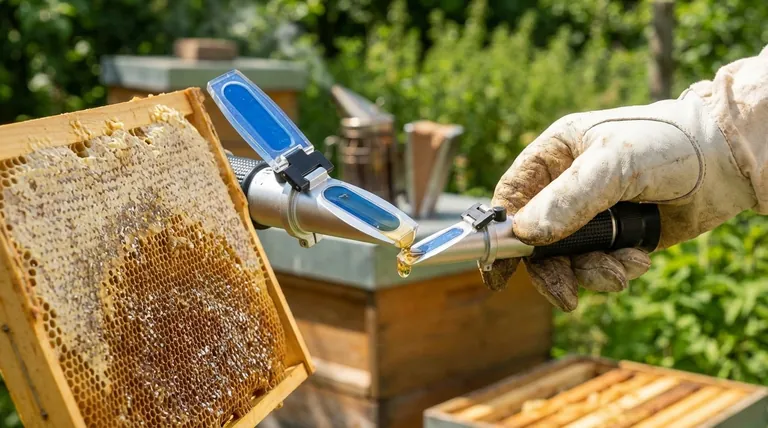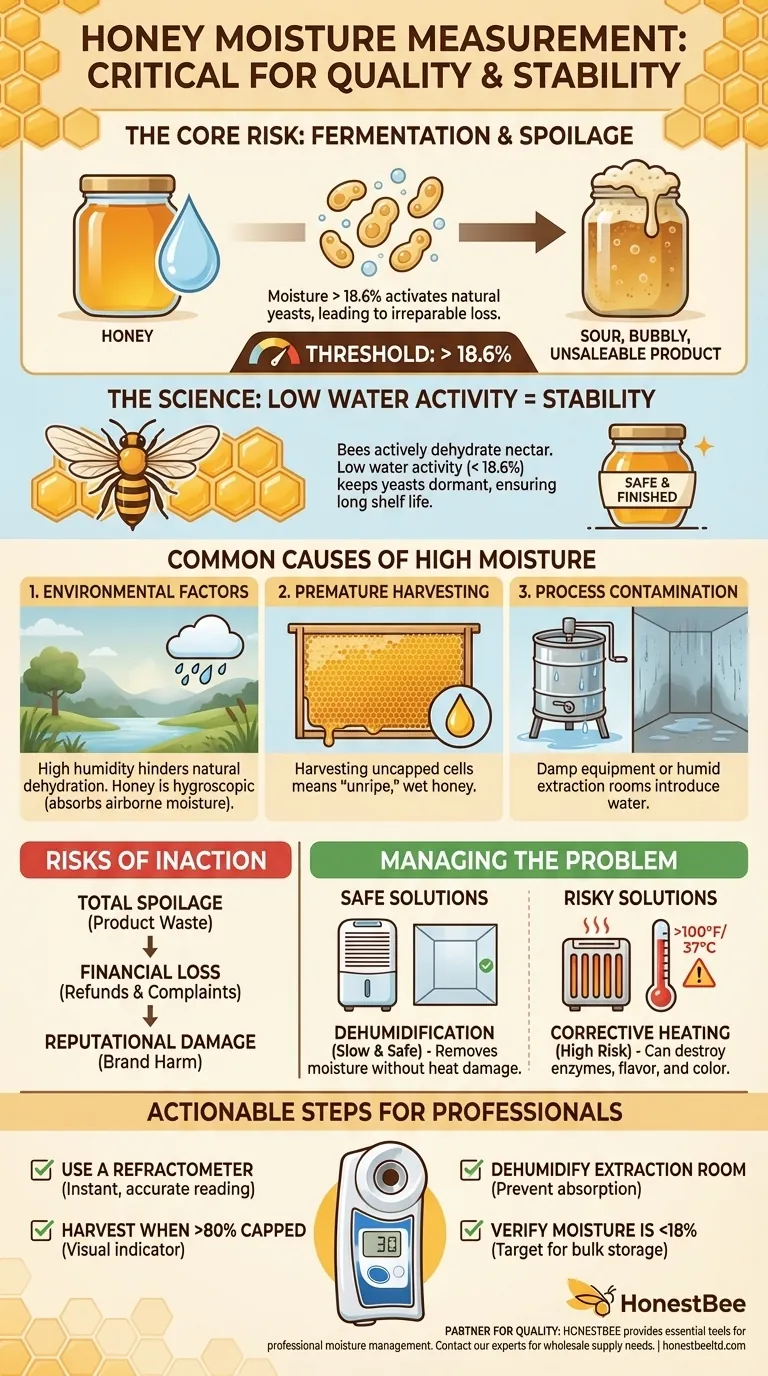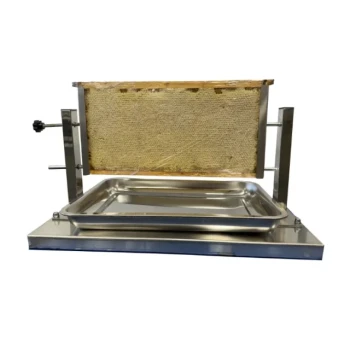To put it simply, you must measure the moisture content of honey before harvesting to prevent it from fermenting and spoiling. If the water content is too high (generally above 18.6%), naturally occurring yeasts in the honey can become active, turning your valuable harvest into a sour, bubbly, and unsellable product. This single measurement is the most critical quality control step to ensure your honey remains stable and preserved indefinitely.
The core issue is biological stability. Honey's legendary shelf life is not guaranteed; it is a direct result of low moisture content that keeps dormant yeasts inactive. Measuring moisture is how you confirm the honey is truly "finished" and safe for long-term storage.

The Science of Honey Stability: Moisture and Yeast
Honey is a supersaturated sugar solution, but it also contains natural, wild yeasts. These yeasts are osmophilic, meaning they can survive in high-sugar environments that would kill other microbes.
Why Low Moisture Prevents Spoilage
The preservation power of honey comes from its low water activity. When moisture content is below 18.6%, there isn't enough free water available for yeast cells to metabolize the sugars and reproduce.
The bees themselves understand this principle. They actively dehydrate the nectar they collect by fanning their wings over the honeycomb cells, reducing the moisture to a stable level before sealing the cell with a wax cap. An uncapped frame is often a sign of "unripe" honey with high moisture.
The Fermentation Threshold
Once moisture levels rise above the 18.6% threshold, the yeast can begin to feed on the honey's sugars. This process produces alcohol and carbon dioxide, leading to a distinct sour taste, a fermented odor, and visible bubbling.
At this point, the honey is considered spoiled. It has lost its desirable flavor, aroma, and commercial value.
What Causes High Moisture Content?
Several factors, both environmental and procedural, can lead to honey with dangerously high moisture levels. Understanding these is key to preventing the problem before it starts.
Environmental Factors
In regions with high humidity or during particularly wet seasons, it is much harder for bees to dehydrate nectar effectively. Honey is also hygroscopic, meaning it will absorb moisture directly from the surrounding air if left exposed.
Premature Harvesting
Harvesting honey frames before the bees have capped the cells is a primary cause of high moisture. A frame that is only partially capped often contains "unripe" honey that the bees have not finished dehydrating.
Contamination During Extraction
Even perfectly cured honey can be ruined during the extraction process. Using equipment that is not completely dry or processing honey in a damp, humid room can introduce enough water to raise the overall moisture content to unsafe levels.
Understanding the Trade-offs: Risks of Poor Moisture Management
Failing to manage moisture content introduces significant risks, while corrective actions have their own set of trade-offs that require careful consideration.
The Primary Risk: Total Spoilage
The most obvious consequence of high moisture is fermentation. This results in a complete loss of the product, wasting the immense effort of both the bees and the beekeeper.
Financial and Reputational Damage
For commercial producers, selling honey that later ferments on the shelf can lead to customer complaints, returns, and severe damage to your brand's reputation for quality.
The Pitfall of Corrective Heating
While you can reduce moisture by gently heating honey, this method is fraught with risk. Overheating, even slightly, can destroy the delicate enzymes and volatile aromatic compounds that give raw honey its unique flavor and health benefits. It can also darken the color and promote crystallization. Using a dehumidifier in a small, sealed room is a much safer, albeit slower, method.
Making the Right Choice for Your Harvest
Your approach to moisture management should be guided by your end goal. The essential tool for this is a honey refractometer, a simple device that provides an instant and accurate moisture reading.
- If your primary focus is long-term bulk storage: Do not harvest until at least 80% of the frame is capped, and verify with a refractometer that the moisture is below 18%.
- If you are in a very humid climate: Invest in a dehumidifier for your extraction room and consider running it for a few days with the uncapped honey supers inside before you extract.
- If you suspect your honey is "wet" after extraction: Act immediately. Use a sealed warming tank or bucket heater set to a very low temperature (never exceeding 100°F or 37°C) or place the honey in a sealed room with a dehumidifier to slowly reduce moisture.
Ultimately, managing moisture is the defining skill that separates a hobbyist from a professional honey producer, ensuring every jar is as stable and perfect as the bees intended.
Summary Table:
| Factor | Risk/Consequence | Prevention/Solution |
|---|---|---|
| Moisture > 18.6% | Fermentation, spoilage, product loss | Use a refractometer before harvest |
| Premature Harvesting | High moisture in uncapped cells | Harvest only when frames are 80% capped |
| High Humidity | Honey absorbs moisture from the air | Use a dehumidifier in the extraction room |
| Wet Equipment | Contamination during processing | Ensure all equipment is completely dry |
Protect your honey harvest and your brand's reputation. As a leading supplier to commercial apiaries and distributors, HONESTBEE provides the essential tools for professional moisture management, including high-quality refractometers and extraction room equipment. Ensure every batch is stable and market-ready. Contact our expert team today to discuss your wholesale supply needs.
Visual Guide

Related Products
- Precision Honey Refractometer Instrument for Quality Assessment
- 8-Frame Electric Self-Reversing Honey Extractor Spinner for Commercial Honey Extraction Equipment
- HONESTBEE 3-Frame Manual Acrylic Honey Extractor
- Professional Thermostatic Conical Honey Melter
- Stainless Steel Manual Honey Press with Guard for Pressing Honey and Wax
People Also Ask
- What is a honey refractometer and what is its purpose? Ensure Honey Quality and Prevent Spoilage
- What are the key steps to using a honey refractometer? Ensure Honey Quality & Prevent Fermentation
- Why is a honey refractometer considered essential for commercial beekeepers? Ensure Honey Quality and Profitability
- Why is a honey refractometer important for beekeepers? Ensure Quality and Prevent Fermentation
- What are the features of the Standard Refractometer for honey moisture content? Essential Tools for Quality Control



















